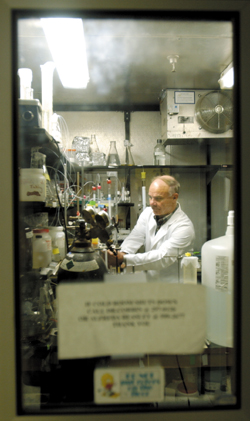
Jackie Corbin works in the cold room in his research lab. Corbin has been a scientist at Vanderbilt for 30 years. (photo by Dana Johnson)
“Imagine” campaign exceeds first goal
The Imagine a World Without Cancer Campaign has surpassed its initial $100 million goal, and the bar has now been raised higher with a $150 million objective that will fully fund the Vanderbilt-Ingram Cancer Center’s 10-year strategic plan.
The campaign was launched in 1999 with a lead pledge from the Ingram Charitable Fund for $56 million, which supported the plan’s first phase. The total of gifts, pledges and bequests as of Oct. 31 brings the total to almost $104 million.
“This is not your typical bricks-and-mortar campaign but rather one that is all about the people and the programs needed to find the cures for cancer,” said Orrin H. Ingram, who serves as chairman of the campaign as well as Vanderbilt-Ingram’s Board of Overseers. “Dr. Hal Moses’ plan focuses resources into the most promising areas of cancer research. From the beginning, we knew we ultimately wanted to fund this plan in its entirety. It is clear now that the entire investment needed is within our reach.”
Ingram noted the importance of so many families, individuals, corporations, foundations and others in Nashville and across the nation participating in the campaign. “Cancer is too big to be conquered by one person or one family,” Ingram said. “We need help from everyone.”
The campaign has four primary objectives:
1. Support of faculty, including creation of endowed chairs to recruit top-flight scientists and keep them from being courted away by other leading cancer centers.
The goal for this objective, initially set at $44 million, has been raised to $60 million. As of Oct. 31, $34.8 million had been raised or committed.
So far, 13 endowed chairs and professorships have been created. In addition, other funds have been targeted for start-up funding for new faculty, and seed funding to enable faculty to establish new programs. The endowed chairs are the Paul V. Hamilton and Virginia E. Howd Chair in Prostate Cancer; the Ann Potter Wilson Chair in Colon Cancer; and 11 Ingram Professorships at the full professor, associate professor and assistant professor levels.
2. Support for programs in research, prevention and compassionate care.
The initial goal of $26 million has been raised to $55 million, and $45.8 million has been raised or committed.
Accomplishments include the seed-funding of a Pain and Symptom Management Program and planned expansion of that program into a comprehensive center for Palliative and Integrative Medicine. In addition, the A.B. Hancock Jr. Memorial Laboratory has been endowed as a Cancer Research Center, which organizes several investigators and their research teams to advance knowledge in cancer research, especially prevention. The Robert J. Kleberg, Jr. and Helen C. Kleberg Center for Cancer Genetics and Genomics was created to explore the functions of genes that are implicated in cancer. Discovery Grants for research have been established for innovative research, and the Preston Research Laboratories for novel research with therapeutic outcomes has been expanded. Several new shared high-tech research facilities have been initiated to support broad research programs, numerous gifts have been made to “Discovery Grant” funds, and new outreach and education programs and the Jade Pasley Pediatric Patient and Family Assistance Fund have been established.
New objectives will focus on further expanding the Pain and Symptom Management/Palliative and Integrative Medicine program, supporting an innovative research and clinical partnership between Vanderbilt-Ingram and Meharry Medical College and the forming of a strong program in epidemiology and population-based research. This effort includes the recently announced Southern Community Cohort Study, a long-range population study that will enroll 105,000 people—two-thirds of them African-American—with the ultimate intent of reducing disparities between these races in cancer incidence and deaths.
3. Support to provide new research and clinical space.
This goal has remained the same, at $20 million. A total of $16.6 million has been raised or committed.
In addition to establishing the Frances Williams Preston Building, accomplishments include the naming of the doctors’ and nurses’ work station and three chemoinfusion rooms in the Henry-Joyce Cancer Clinic, renovations of the Breast Center and the Brian Scott Walls Conference Room in the Preston Building.
The only campaign funds used for facility construction or improvement target projects necessary for recruitment of new clinical and research faculty. Construction and renovation plans are part of an overall medical center growth plan. The recently completed Preston Building is designed to bring together—in the most cost-effective way—cancer center leadership, new faculty in epidemiology and bioinformatics, clinical trials and other administrative staff, who previously were scattered throughout the campus. As a result, the Center also will gain 13 new research laboratories and clinic exam rooms previously occupied by these programs.
4. Support to train the next generation of cancer scientists and doctors.
The goal has been raised from $10 million to $15 million, and $1.7 million has been raised or committed.
Accomplishments include establishing several fellowships for training of future medical, surgical, radiation or pediatric oncologists and future cancer scientists. These include the Harry Joyce Medical Oncology Fellowships, pediatric oncology fellowships and the Sylvia DeBoalt Fund for Medical Oncology Training.













